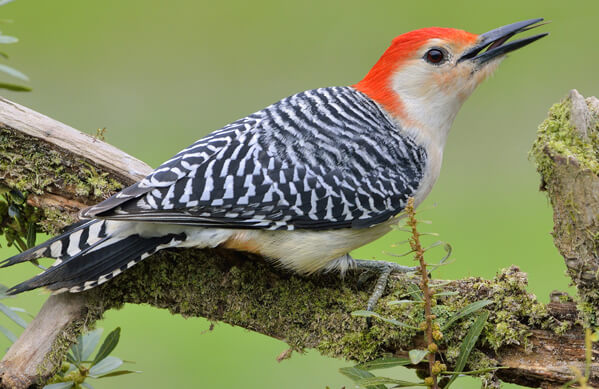Woodpeckers in Florida: Nature, Ecology, and Conservation
Woodpeckers in Florida: Nature, Ecology, and Conservation
Blog Article
Woodpeckers Unleashed: Checking Out the Wonders of These Skilled Tree Mountain Climbers
Woodpeckers, with their unique markings and balanced drumming echoing with wooded areas, hold a special location in the bird globe. Their specialized anatomy and adaptations allow them to browse vertical surface areas with unmatched ability. Their proficiency of tree climbing is simply one aspect of their interesting behavior. As we explore the elaborate information of woodpeckers' nesting practices, feeding strategies, and the recurring conservation initiatives to safeguard these exceptional birds, a deeper gratitude for their location in nature unravels.
Composition and Adaptations
When analyzing the composition and adaptations of woodpeckers, one can observe impressive features that make it possible for these birds to thrive in their specialized environmental particular niche. Furthermore, woodpeckers have zygodactyl feet, with 2 toes dealing with ahead and two encountering backwards, supplying a company grip on tree trunks while they look for food or drum for communication.
Moreover, woodpeckers have an unique tongue framework that is long, barbed, and sticky, allowing them to draw out bugs from holes in timber. This customized adaptation permits woodpeckers to exploit a food source that is inaccessible to many other bird varieties. In general, the anatomy and adjustments of woodpeckers display the impressive transformative solutions that have actually allowed these birds to grow in their arboreal habitat.
Drumming Actions
Having actually discovered the anatomy and adaptations of woodpeckers, the emphasis now moves to comprehending their drumming habits, a distinctive facet of their communication and territorial displays. Drumming is an essential type of interaction amongst woodpeckers, offering several objectives such as establishing regions, attracting companions, and signaling alarm. Each woodpecker types has an one-of-a-kind drumming pattern that aids individuals identify participants of their own species and differentiate them from rivals or predators.
Woodpeckers generate drumming audios by swiftly pecking on resonant surface areas such as dead trees, utility posts, or perhaps metal things, developing a series of balanced beats. The intensity and rate of drumming can vary based on the purpose; for example, a quick drumming series might represent aggressiveness in the direction of burglars, while a slower and softer drumming pattern might indicate courtship (Woodpeckers in Florida). Additionally, woodpeckers might adjust the regularity and period of their drumming to convey certain messages effectively
Nesting Routines
Checking out the nesting behaviors of woodpeckers exposes fascinating insights into their reproductive habits and habitat choices. Woodpeckers are understood for their distinct nesting choices, frequently excavating cavities in trees to develop sheltered areas for raising their young. These cavities offer not only as a nesting website yet additionally as a safe haven from killers and inclement weather condition.
Woodpeckers show a high level of fidelity to their nesting sites, commonly going back to the exact same location year after year. This behavior highlights the importance of ideal environment accessibility for their reproductive success. The choice of a nesting site is vital for woodpeckers, with factors such as tree varieties, height, and degeneration phase playing significant duties in their decision-making process.
Interestingly, some woodpecker species are understood to dig deep into multiple tooth cavities within their region, supplying themselves with alternative nesting alternatives. This method may Source function as Continued a type of insurance against potential hazards or disturbances to their key nesting website.

Feeding Techniques
Woodpeckers utilize a range of specialized feeding strategies to procure their primary food resources. One of one of the most distinct feeding behaviors of woodpeckers is drumming, which involves rapid pecking on trees to uncover insects underneath the bark. This drumming not just helps them find prey however additionally works as a method of interaction with other woodpeckers. Woodpeckers have strong, chisel-like beaks that enable them to pierce right into timber easily. When an opening is created, they utilize their lengthy, barbed tongues to remove pests such as ants, beetles, larvae, and crawlers. These tongues are covered with sticky saliva that helps trap the prey. Woodpeckers are likewise understood to excavate tooth cavities in trees to accessibility surprise insect larvae or sap. Some varieties, like the acorn woodpecker, shop nuts in particularly produced openings called granaries. This critical keeping of food assists them make it through during food shortage periods. Woodpeckers are genuinely exceptional in their feeding methods, showcasing versatility and knowledge in obtaining their nourishment.
Preservation Efforts
Amidst the elaborate feeding methods showed by woodpeckers, the conservation efforts aimed at guarding these interesting birds play an essential duty in protecting their environments and populations. Woodpeckers encounter numerous threats to their survival, including habitat loss as a result of logging, environment adjustment altering their environments, and collisions with man-made frameworks such as structures and vehicles - Woodpeckers in Florida. Guardians are actively working to resolve these difficulties and make sure the lasting health of woodpecker varieties

Education and learning and public recognition campaigns are also crucial parts of woodpecker preservation initiatives. By raising recognition regarding the discover this info here value of these birds in keeping healthy and balanced woodland environments, guardians can garner assistance for habitat conservation efforts and promote responsible land administration practices. Through joint efforts in between researchers, policymakers, and regional neighborhoods, we can interact to protect a future where woodpeckers prosper in their all-natural environments.
Verdict

Report this page